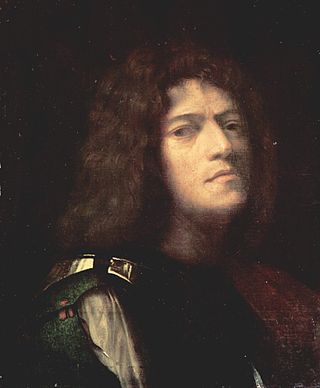
Giorgio Barbarelli da Castelfranco, known as Giorgione, was an Italian painter of the Venetian school during the High Renaissance, who died in his thirties. He is known for the elusive poetic quality of his work, though only about six surviving paintings are firmly attributed to him. The uncertainty surrounding the identity and meaning of his work has made Giorgione one of the most mysterious figures in European art.

Tiziano Vecellio, Latinized as Titianus, hence known in English as Titian, was an Italian Renaissance painter, the most important artist of Renaissance Venetian painting. He was born in Pieve di Cadore, near Belluno. During his lifetime he was often called da Cadore, 'from Cadore', taken from his native region.

Paolo Caliari, known as Paolo Veronese, was an Italian Renaissance painter based in Venice, known for extremely large history paintings of religion and mythology, such as The Wedding at Cana (1563) and The Feast in the House of Levi (1573). Included with Titian, a generation older, and Tintoretto, a decade senior, Veronese is one of the "great trio that dominated Venetian painting of the cinquecento" and the Late Renaissance in the 16th century. Known as a supreme colorist, and after an early period with Mannerism, Paolo Veronese developed a naturalist style of painting, influenced by Titian.

Alessandro Bonvicino, more commonly known as Moretto, or in Italian Il Moretto da Brescia, was an Italian Renaissance painter from Brescia, where he also mostly worked. His dated works span the period from 1524 to 1554, but he was already described as a master in 1516. He was mainly a painter of altarpieces that tend towards sedateness, mostly for churches in and around Brescia, but also in Bergamo, Milan, Verona, and Asola; many remain in the churches they were painted for. The majority of these are on canvas, but a considerable number, including some large pieces, are created on wood panels. There are only a few surviving drawings from the artist.

Paolo Farinati was an Italian painter of the Mannerist style, active in mainly in his native Verona, but also in Mantua and Venice.
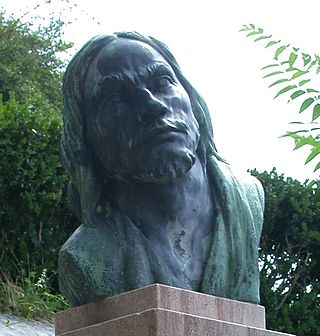
Pordenone, Il Pordenone in Italian, is the byname of Giovanni Antonio de’ Sacchis, an Italian Mannerist painter, loosely of the Venetian school. Vasari, his main biographer, wrongly identifies him as Giovanni Antonio Licinio. He painted in several cities in northern Italy "with speed, vigor, and deliberate coarseness of expression and execution—intended to shock".

The Assumption of the Virgin or Frari Assumption, popularly known as the Assunta, is a large altarpiece panel painting in oils by the Italian Renaissance artist Titian, painted in 1515–1518. It remains in the position it was designed for, on the high altar of the Basilica di Santa Maria Gloriosa dei Frari or Frari church in Venice. It is the largest altarpiece in the city, with the figures well over life-size, necessitated by the large church, with a considerable distance between the altar and the congregation. The images above and below are not Titian's work, they are by Palma Vecchio.
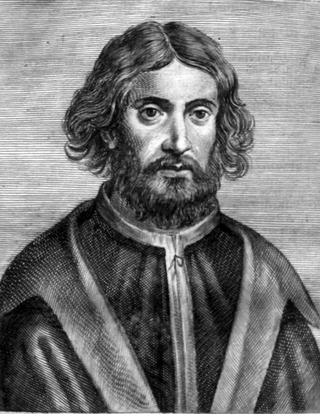
Palma Vecchio, born Jacopo Palma, also known as Jacopo Negretti, was a Venetian painter of the Italian High Renaissance. He is called Palma Vecchio in English and Palma il Vecchio in Italian to distinguish him from Palma il Giovane, his great-nephew, who was also a painter.

The Crucifixion is a life sized painting by the Venetian artist Titian, completed in 1558 and presently hanging in the sanctuary of the church of San Domenico, Ancona. Jesus Christ is shown crucified, with Saint Mary and Saint John standing either side of the cross in the Stabat Mater tradition. The kneeling figure is of Saint Dominic. The canvas was completed during Titian's fifth decade of painting, and is one of the works marking a shift toward his extensive exploration of tragedy and human suffering.
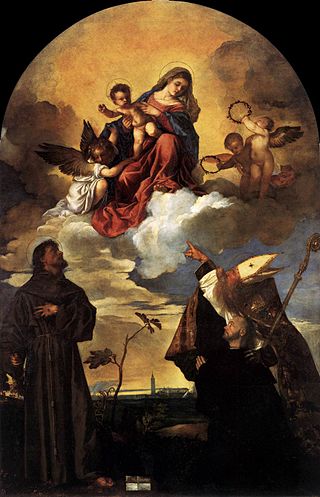
The Gozzi Altarpiece is an oil painting by the Italian Renaissance master Titian, dating from 1520. It is located in the Pinacoteca civica Francesco Podesti, in Ancona.
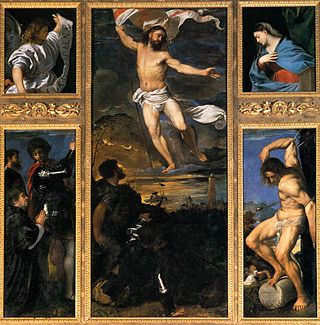
The Averoldi Polyptych, also known as the Averoldi Altarpiece, is a painting by the Italian Renaissance painter Titian, dating to 1520–1522, in the basilica church of Santi Nazaro e Celso in Brescia, northern Italy.
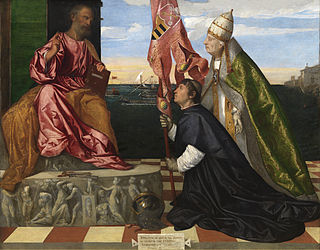
Jacopo Pesaro being presented by Pope Alexander VI to Saint Peter is an oil painting on canvas by Titian, now in the Royal Museum of Fine Arts in Antwerp.

The Martyrdom of Saint Lawrence is a Renaissance era oil painting by the Venetian artist Titian, dated from 1558. It depicts the Ancient Romans' murder of Saint Lawrence and was originally an altarpiece in the Church of Santa Maria Assunta dei Crociferi, although it is now in the church of I Gesuiti in Venice.

The Deaf-Mute Filippo Viotti's Vision of the Virgin Mary is an oil on canvas painting by Moretto da Brescia, executed c. 1534, displayed in the Santuario della Madonna at Paitone in the Province of Brescia, Italy. It is first recorded in 1648 by Carlo Ridolfi, who wrote that "in the church atop Monte Paitone one can still admire a miraculous image of the Virgin which Moretto made at the request of that town for such a miracle".

Supper in the House of Simon the Pharisee is a 1544 oil on canvas painting by Moretto da Brescia, now in the Chiesa della Pietà in Venice, Italy.

The Assassination of Saint Peter Martyr or The Martyrdom of Saint Peter of Verona is a 1530–1535 oil on canvas painting by Moretto da Brescia, now in the Sala dell'Esedra in the Pinacoteca Ambrosiana in Milan.

The Luzzago Altarpiece is a 1542 oil on canvas painting by Moretto da Brescia, now in the Pinacoteca Tosio Martinengo in Brescia. It was recorded in San Giuseppe church in Brescia in 1630 and moved to its present home in 1868. In the lower register Michael the Archangel points the kneeling donor to the Madonna and Child above, whilst Francis of Assisi stands to the right with a cross.
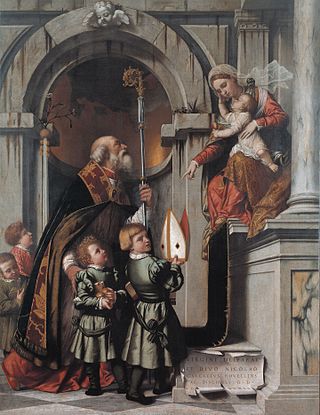
The Rovelli Altarpiece is a 1539 oil on canvas painting by Moretto da Brescia, which since 1899 has been in the Pinacoteca Tosio Martinengo in Brescia, Italy. Strongly influenced by Titian, it is named after the schoolmaster Galeazzo Rovelli who commissioned it for the church of Santa Maria dei Miracoli in Brescia in 1539, where it remained until being removed in the 19th century and replaced by a copy. Its composition was reused by Moroni in his Mystic Marriage of Saint Catherine in the 1560s.

St Justina of Padua with a Donor is an oil on panel painting by Moretto da Brescia, executed c. 1530, now in the Kunsthistorisches Museum in Vienna, to which it was transferred in the late 19th century soon after the museum's opening. It shows Justina of Padua.

The Martyrdom of Saint Peter Martyr is an oil-on-panel painting created c. 1526–1528 by the Italian Renaissance painter Palma Vecchio, now in the Museo d'arte sacra San Martino in Alzano Lombardo.






















